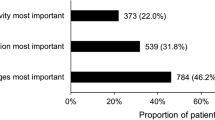Abstract
Background
Studies in patients with dyslipidemia have revealed that, despite guideline recommendations, treatment remains unchanged even when therapeutic goals are not achieved.
Objective
Our objective was to determine the degree to which primary care (PC) and specialty care (SC) physicians adhere to clinical guidelines for the management of atherogenic dyslipidemia (AD).
Methods
This was an observational, descriptive, cross-sectional study. Physicians working in the Spanish Health System completed an electronic questionnaire comprising 24 items organized into three blocks: clinical guidelines, adherence to clinical guidelines, and other issues in the management of AD. The questions were formulated with closed polytomous or categorized responses. Adherence to guidelines, in terms of treatment, was assessed according to physicians’ responses to six patient profiles. Absolute and relative frequencies (qualitative variables), central tendency and dispersion (quantitative variables) were calculated.
Results
In total, 980 physicians (88.5% PC) participated in the study; 77.3% used guidelines in their routine clinical practice, with the most used being the Spanish SEMERGEN (73.8%) and the European Society of Cardiology/European Atherosclerosis Society guidelines (41.2%). A total of 83% adhered to guideline recommendations in more than four of the six profiles proposed, 26.2% adhered to the SEMERGEN definition of AD, 66.6% combined all lipoprotein ratios to diagnose AD, and > 60% used non-high-density lipoprotein cholesterol (HDL-C) to diagnose patients with AD at high cardiovascular risk. In total, 99.0% prescribed a fibrate to reduce triglyceride levels, 47.4% to increase HDL-C levels and 40.2% to reduce small, dense low-density lipoprotein cholesterol particles.
Conclusion
Since adherence to clinical guidelines improves both the quality of care and health outcomes, greater adherence to and satisfaction with clinical guidelines for the management of AD may contribute to improvements in and optimization of the management of patients with AD in the Spanish health system.


Similar content being viewed by others
References
Millan Nuñez-Cortés J, Pedro-Botet Montoya J, Pintó Sala X. Dislipidemia aterogénica y riesgo residual. Estado de la cuestión en 2014. Clin Investig Arterioscler. 2014;26:287–92.
Rodríguez Á, Núñez-Cortés JM, Blasco Valle MPEF. Guía clínica para la detección, diagnóstico y tratamiento de la dislipemia aterogénica en atención primaria. 2013. http://www.se-arteriosclerosis.org/assets/dislipemia-aterogénica.pdf. Accessed June 2018.
Barter P, Gotto AM, LaRosa JC, et al. HDL cholesterol, very low levels of LDL cholesterol, and cardiovascular events. N Engl J Med. 2007;357(13):1301–10.
Buring JE, Mora S, Sacks FM, et al. Fasting compared with nonfasting triglycerides and risk of cardiovascular events in women. JAMA. 2015;298(3):309–16.
Lau DCW, Yan H, Dhillon B. Metabolic syndrome: a marker of patients at high cardiovascular risk. Can J Cardiol. 2006;22(Suppl B):85B–90B.
Millán J, Hernández-Mijares A, Ascaso JF, et al. La auténtica dimensión del colesterol-no-HDL: colesterol aterogénico. Clin Investig Arterioscler. 2016;28:265–70.
Sánchez-Chaparro M, González-Santos P, Valdivieso-Felices P, et al. Prevalencia de dislipidemiaaterogénica en población laboral Española. Grupo de Estudio “ICARIA”. 18a Reunión Nacional de la Sociedad Española de Hipertensión, Liga Española para la Lucha contra la Hipertensión Arterial. Valencia, 6 al 8 de Marzo, 2013.
Ascaso JF, Millán J, Hernández-Mijares A, et al. Documento de consenso sobre el manejo de la dislipemia aterogénica de la Sociedad Española de Arteriosclerosis. Clin Investig Arterioscler. 2017;29:86–91.
Pedro-Botet J, Millán J, Brea Á, et al. Decálogo de recomendaciones clínicas en dislipidemia aterogénica. Clin Investig Arterioscler. 2014;26:38–40.
Reiner Z, Catapano AL, De Backer G, et al. ESC/EAS guidelines for the management of dyslipidaemias: the Task Force for the management of dyslipidaemias of the European Society of Cardiology (ESC) and the European Atherosclerosis Society (EAS). Eur Heart J. 2011;32(14):1769–818.
Catapano AL, Graham I, De Backer G, et al. 2016 ESC/EAS guidelines for the management of dyslipidaemias. Eur Heart J. 2016;37(39):2999–3058.
Chapman MJ, Redfern JS, McGovern ME, et al. Niacin and fibrates in atherogenic dyslipidemia: pharmacotherapy to reduce cardiovascular risk. Pharmacol Ther. 2010;126:314–45.
Moutzouri E, Kei A, Elisaf MS, et al. Management of dyslipidemias with fibrates, alone and in combination with statins: role of delayed-release fenofibric acid. Vasc Health Risk Manag. 2010;6:525–39.
Shepherd J, Barter P, Carmena R, et al. Effect of lowering LDL cholesterol substantially below currently recommended levels in patients with coronary heart disease and diabetes: the Treating to New Targets (TNT) study. Diabetes Care. 2006;29:1220–6.
Deedwania P, Barter P, Carmena R, et al. Reduction of low-density lipoprotein cholesterol in patients with coronary heart disease and metabolic syndrome: analysis of the Treating to New Targets study. Lancet. 2006;368:919–28.
Kotseva K, Wood D, De Backer G, et al. EUROASPIRE III: management of cardiovascular risk factors in asymptomatic high-risk patients in general practice: cross-sectional survey in 12 European countries. Eur J Cardiovasc Prev Rehabil. 2010;17(5):530–40.
Pearson TA, Laurora I, Chu H, et al. The Lipid Treatment Assessment Project (L-TAP): a multicenter survey to evaluate the percentages of dyslipidemic patients receiving lipid-lowering therapy and achieving low-density lipoprotein cholesterol goals. Arch Intern Med. 2000;160(4):459–67.
Fonarow GC, French WJ, Parsons LS, et al. Use of lipid-lowering medications at discharge in patients with acute myocardial infarction : data from the National Registry of Myocardial Infarction 3. Circulation. 2001;103:38–44.
Goldberg KC, Melnyk SD, Simel DL. Overcoming inertia: improvement in achieving target low-density lipoprotein cholesterol. Am J Manag Care. 2007;13:530–4.
Primatesta P, Poulter NR. Lipid concentrations and the use of lipid lowering drugs: evidence from a national cross sectional survey. BMJ. 2000;321:1322–5.
Martínez-Hernández A, Aguilar-Leñero M, Mengíbar MR, et al. Prevención secundaria de cardiopatía isquémica a nivel lipídico en atención primaria Aragón. Estudio PRECIAR. Rev Esp Salud Pública. 2001;75:143–50.
Banegas JR, Vegazo O, Serrano P, et al. The gap between dyslipidemia control perceived by physicians and objective control patterns in Spain. Atherosclerosis. 2017;188(2):420–4.
Lázaro P, Murga N, Aguilar D, et al. Inercia terapéutica en el manejo extrahospitalario de la dislipemia en pacientes con cardiopatía isquémica. Estudio Inercia. Rev Española Cardiol. 2010;63:1428–37.
Ministerio de Sanidad, Política Social e Igualdad. Informe sobre oferta y necesidad de especialistas médicos en España. 2010–2025. 2011. Accessed Nov 2016.
Alfonso F, Bermejo J, Segovia J. Guías Europeas de Práctica Clínica en Revista Española de Cardiología. ¿Hacia una completa «globalización» de la asistencia cardiovascular? Rev Española Cardiol. 2004;57:1000–2.
Woolf SH, Grol R, Hutchinson A, et al. Clinical guidelines: potential benefits, limitations, and harms of clinical guidelines. BMJ. 1999;318:527–30.
Constantino-Casas P, Viniegra-Osorio A, Medécigo-Micete C, et al. El potencial de las guías de práctica clínica para mejorar la calidad de la atención. Rev Med Inst Mex Seguro Soc. 2009;47:103–8.
Vashitz G, Meyer J, Parmet Y, et al. Physician adherence to the dyslipidemia guidelines is as challenging an issue as patient adherence. Fam Pract. 2011;28:524–31.
McKinlay JB, Link CL, Freund KM, et al. Sources of variation in physician adherence with clinical guidelines: results from a factorial experiment. J Gen Intern Med. 2007;22:289–96.
Kenefick H, Lee J, Fleishman V. Improving physician adherence to clinical practice guidelines: barriers and strategies for change. Cambridge: New England Healthcare Institute (NEHI); 2008.
Soutelo J, Graffigna M, Honfi M, et al. Índice triglicéridos/HDL-colesterol: en una población de adolescentes sin factores de riesgo cardiovascular. Arch Latinoam Nutr. 2012;62:167–71.
Pallarés-Carratalá V, Esteban-Giner MJ, Giner-Galvañ V. Overview of guidelines for the management of dyslipidemia: EU perspectives. Vasc Health Risk Manag. 2016;12:357–69.
Cabana MD, Davis MM. Improving physician adherence to cholesterol management guidelines. Manag Care. 2002;11:18–22.
Pallazola V, Hla D, Arvanitis M, et al. Major dyslipidemia guidelines and their discrepancies: a need for consensus. 2008. http://www.acc.org, Accessed June 2018.
Acknowledgements
The authors acknowledge the physicians who participated in this study. They also acknowledge Mariona Lería (Medical Department Head/Product Safety & Risk Management) and Outcomes’10 for support with the study coordination.
Author information
Authors and Affiliations
Corresponding author
Ethics declarations
Data confidentiality
Data confidentiality of all participants was respected at all times. Information about the identity of the participants was considered confidential for all intents and purposes and was stored and handled in accordance with Organic Law 15/1999 of 13 December 1999 on the Protection of Personal Data.
Informed consent
All study participants received adequate information and agreed to participate before inclusion.
Funding
This study was sponsored by BGP Product Operations S.L (Mylan).
Conflict of interest
JMNC has no conflicts of interest that are directly relevant to the content of this article. PRF, MMK, MRM and MLOP work at BGP Product Operations S.L (Mylan). SA works for an independent research organization (Outcomes’10, S.L.), which has received fees for contributions to the development and coordination of the project and to the writing of this manuscript.
Electronic supplementary material
Below is the link to the electronic supplementary material.
Rights and permissions
About this article
Cite this article
Núñez-Cortés, J., Rodríguez-Fortúnez, P., Melogno-Klinkas, M. et al. Management of atherogenic dyslipidemia according to current treatment guidelines: DESPEGA study in real clinical practice. Drugs Ther Perspect 35, 192–199 (2019). https://doi.org/10.1007/s40267-019-00605-z
Published:
Issue Date:
DOI: https://doi.org/10.1007/s40267-019-00605-z




